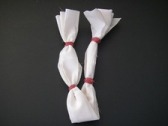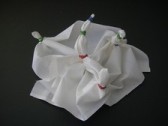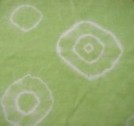Tie Dye - A vintage look re-vamped
Create your own colour and pattern

Tie Dye means tying fabric and then dying it with a colour.
Material that was decorated with this effect has been used for many years. The 60's decade saw a return of the this with the young generation wanting to decorate their clothes in their unique way, with their choice of colours. The 80's decade again saw a revival in a art form with complicated designs.
This type of fabric decoration was used a lot in China and Japan in the very early centuries. They were able to use the hemp and silk that they grew and this fibre worked really well with the tie-dying effect.
In Western China, South East Asia and Central America some of the very early settlers had their version known as IKAT. This was when they dyed the threads before weaving them into cloth.
In earlier days the dyes were made from flowers, berries, roots and leaves of plants, with a popular one being indigo which is still used today. One of the main disadvantages with these kind of dyes was that they faded with sunlight.
Nowadays these dyes are synthetic and have the properties of being permanent, easy to use (as they can be used in a washing machine) and fix quickly.
Natural fabrics are the best to choose when tye dying and these are then tied with either string, elastic bands, paper clips or anything else that will stop the dye from reaching that part of the fabric.
Tie Dye Effects and Patterns
 Tied in straight lines
Tied in straight lines Tied in peaks on larger fabric
Tied in peaks on larger fabric Multiple ties in a circle
Multiple ties in a circle


One of the main points to remember when using two or more dyes is to think about the final fabric colour as the dyes that you use will all react with one another.
For example if you wanted your fabric green you could use yellow and blue dyes. This would give the green end result but will also give 3 different colours in your pattern if your original fabric was white.
The fabric, which should be washed first, can be tied in either a set or random pattern. There are books that can give you details of what pattern will emerge from tying the material in a certain way. But really it is best just to have a go and see if you like the result. Follow the instructions on the dye packets after you have tied your material.
If you are pleased with the result why not show us by putting a picture on the cushion gallery. Some of the end results could be quite spectacular.
Have fun with your tie dye and enjoy................
Affiliate offers
Please take care with any soft furnishing that it does not come into contact with any heat source.
If you have found an error on this page or want some more information on sewing cushions.
Please contact me . Thank you
New! Comments
Have your say about what you just read! Leave me a comment in the box below.